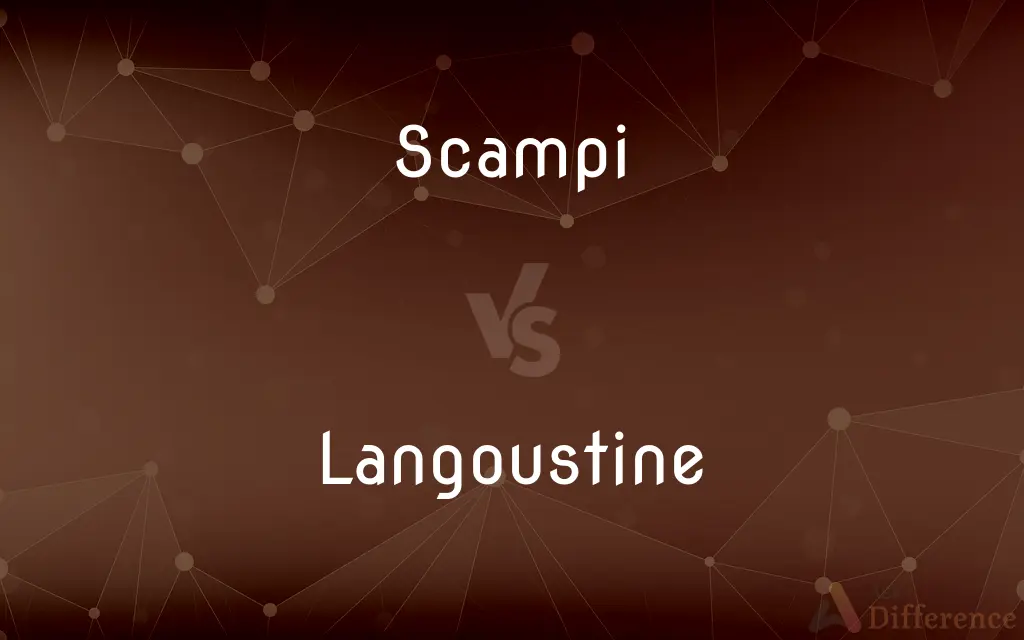Scampi vs. Langoustine — What's the Difference?
Edited by Tayyaba Rehman — By Maham Liaqat — Updated on April 8, 2024
Scampi and langoustine refer to the same shellfish in biological terms, but culinary usage differs; scampi often means a dish, whereas langoustine is the creature itself.

Difference Between Scampi and Langoustine
Table of Contents
ADVERTISEMENT
Key Differences
Scampi and langoustine are terms often used interchangeably, but they highlight different aspects of the same shellfish in culinary contexts. Scampi, in many English-speaking countries, refers to a specific preparation style of shellfish, often involving breaded and fried shrimp, while in Italian cuisine, it refers to the shellfish itself, also known as the Norway lobster. Langoustine, on the other hand, is a term more commonly used in Europe to refer to the raw or cooked form of this crustacean, emphasizing its fresh, sweet meat and its role in various gourmet dishes.
Scampi, when mentioned in the context of dishes in the United States and the United Kingdom, often conjures images of shrimp cooked in garlic butter, wine, and sometimes breadcrumbs. This preparation is distinct from the original Italian usage of the term, which specifically refers to the Norway lobster. Langoustines, however, are typically prepared more simply to highlight their delicate flavor, often grilled or boiled and served with minimal seasoning or in elaborate dishes that showcase their natural taste.
In terms of availability and culinary use, scampi dishes are widely popular in casual dining and home cooking, often using shrimp as a more readily available substitute for the Norway lobster. Langoustines, prized for their sweet, tender meat, are considered a delicacy and are more commonly found in upscale restaurants and in regions close to their cold-water habitats.
The terminology can also reflect regional seafood traditions and preferences. In areas where scampi is prepared using actual Norway lobster, the dish maintains a closer connection to its original definition, emphasizing the quality and flavor of the shellfish. Langoustine, used in its purest form, showcases European culinary traditions that focus on the freshness and simplicity of seafood.
The confusion between scampi and langoustine in culinary terms highlights the evolving nature of food language and how regional interpretations can influence the understanding and preparation of seafood dishes. While both terms can technically refer to the same creature, the context in which they are used—whether referring to a specific style of preparation or the shellfish itself—can significantly affect their meaning.
ADVERTISEMENT
Comparison Chart
Definition
Refers both to a specific dish of shellfish prepared with garlic butter and breadcrumbs and to the shellfish itself in Italian.
The term for the raw or cooked Norway lobster, focusing on the shellfish itself rather than a preparation style.
Culinary Usage
Often indicates a preparation style in English-speaking countries, especially dishes with shrimp.
Used to describe the shellfish in its pure form, especially in European culinary contexts.
Preparation
Typically breaded and fried or cooked in garlic butter and wine.
Often grilled or boiled, served with minimal seasoning to highlight its flavor.
Availability in Cuisine
Common in casual dining and home cooking, often using shrimp.
Considered a delicacy, more common in upscale restaurants.
Regional Preference
The term scampi is more flexible in English-speaking countries, adapting to local seafood availability.
Langoustine is closely tied to European seafood traditions, emphasizing freshness and simplicity.
Compare with Definitions
Scampi
A culinary preparation involving shellfish, often shrimp, cooked with garlic, butter, and sometimes breadcrumbs.
For dinner, we made scampi with a generous serving of garlic butter.
Langoustine
Prized in upscale dining for its delicate flavor and texture.
The chef prepared the langoustines with a light herb sauce to enhance their natural taste.
Scampi
The term adapts to include various shellfish based on regional availability.
Locally sourced shrimp were used in our scampi recipe to great effect.
Langoustine
Often boiled or grilled to preserve their flavor.
Grilled langoustines served with just a pinch of salt were a simple yet exquisite dish.
Scampi
In Italian cuisine, refers to the Norway lobster (Nephrops norvegicus).
Fresh scampi are prized in Italian seafood dishes for their delicate taste.
Langoustine
A type of shellfish, also known as Norway lobster, known for its sweet, tender meat.
Langoustines were the centerpiece of the elaborate seafood platter.
Scampi
Can be prepared breaded and fried or sautéed in a garlic butter sauce.
We experimented with both fried and sautéed scampi for our seafood feast.
Langoustine
Considered a luxury ingredient in many cuisines.
The langoustine risotto was a decadent dish, showcasing the shellfish's premium quality.
Scampi
A popular dish in casual and home settings, often featuring shrimp.
The restaurant's scampi, served with a side of pasta, was a hit among diners.
Langoustine
Strongly associated with European cuisine, highlighting freshness and simplicity.
In our French-inspired menu, langoustines were served alongside classic accompaniments.
Scampi
Scampi, also called Dublin Bay Prawn or Norway Lobster (Nephrops norvegicus), is an edible lobster of the order Decapoda. It is widespread in the Mediterranean and northeastern Atlantic, from North Africa to Norway and Iceland, and is a gastronomic delicacy.
Langoustine
A small edible lobster (Nephrops norvegicus) of the eastern Atlantic Ocean and the Mediterranean Sea, having slender claws. Also called Norway lobster, scampi.
Scampi
Large shrimp broiled or sautéed and served in a garlic and butter sauce.
Langoustine
A small edible European orange-pink lobster, Nephrops norvegicus
Scampi
See langoustine.
Langoustine
Caught in European waters; slenderer than American lobster
Scampi
Served in a garlic and butter sauce
Lobster scampi.
Scampi
A Norway lobster (Nephrops norvegicus).
Scampi
Any member of a similar species of genus Nephrops or similar prawns.
Scampi
Plural of scampo
Scampi
Large shrimp sauteed in oil or butter and garlic
Common Curiosities
How are scampi usually prepared?
Scampi is typically prepared by sautéing in garlic butter, sometimes with breadcrumbs or fried.
What is the difference between scampi and shrimp?
Scampi originally refers to the Norway lobster, while shrimp are a different type of shellfish; however, in some dishes, shrimp may be used as a substitute for scampi.
Is langoustine expensive?
Yes, langoustines are considered a delicacy and can be more expensive than other shellfish.
What are langoustines?
Langoustines are a type of shellfish, also known as Norway lobster, prized for their sweet, tender meat.
Can scampi and langoustine be used interchangeably in recipes?
In recipes, scampi can refer to the dish or the shellfish; langoustine specifically refers to the shellfish and can be substituted depending on the recipe context.
What does langoustine taste like?
Langoustine meat is sweet and tender, often compared to lobster but with a more delicate flavor.
Where are langoustines found?
Langoustines are found in cold waters, particularly around the coasts of the North Atlantic and the Mediterranean Sea.
What are scampi?
Scampi refers to a dish made with shellfish, often shrimp, cooked in garlic butter and wine, and to the Norway lobster in Italian cuisine.
How should langoustines be cooked?
Langoustines are best cooked simply, either boiled or grilled, to highlight their natural flavor.
Is there a difference in preparation between scampi and langoustine dishes?
Yes, scampi dishes often involve a garlic butter sauce, whereas langoustines are usually prepared more simply to emphasize their flavor.
Are langoustines sustainable seafood?
Langoustines can be a sustainable choice depending on their source and method of catch; it's important to check for sustainability certifications.
Can I substitute shrimp for langoustines in recipes?
Yes, shrimp can be substituted for langoustines in recipes, though there will be a difference in flavor and texture.
Are scampi dishes only made with shellfish?
While traditional scampi dishes involve shellfish, variations exist that may incorporate other types of seafood or even chicken.
What is the origin of the term scampi?
The term scampi comes from Italian, where it refers to the Norway lobster.
Why are langoustines considered a delicacy?
Langoustines are considered a delicacy due to their sweet flavor, tender texture, and relative rarity compared to other shellfish.
Share Your Discovery

Previous Comparison
Rule vs. Guideline
Next Comparison
Ocular vs. OphthalmicAuthor Spotlight
Written by
Maham LiaqatEdited by
Tayyaba RehmanTayyaba Rehman is a distinguished writer, currently serving as a primary contributor to askdifference.com. As a researcher in semantics and etymology, Tayyaba's passion for the complexity of languages and their distinctions has found a perfect home on the platform. Tayyaba delves into the intricacies of language, distinguishing between commonly confused words and phrases, thereby providing clarity for readers worldwide.
















































